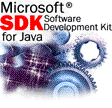Using package-managed classes with
existing tools:A tool called clspack creates all the ZIP files that are usually
included in %WINDIR%\Java\Classes, and are now stored in the package manager. It is
provided in the SDK\bin directory. You can use it by setting the path to the SDK\bin (set
path=c:\sdk-java.20\bin;%path%) or copying it into %windir% directory.
In addition, the value of the CLASSPATH
registry setting is prepended with a reference to this generated classes.zip file (if one
is not currently there). The compiler provided with the SDK (jvc.exe) checks this location
by default for classes, so there is no need to set the CLASSPATH environment variable.
For other compilers that do not check
this location by default, set the CLASSPATH environment variable with:
set
CLASSPATH=%WINDIR%\Java\Classes\Classes.zip
before running the compiler. It's a good
idea to place this command in a batch file for easy use.
